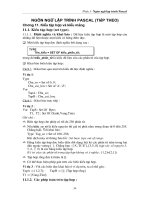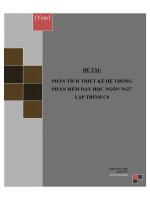Giới thiệu môn học ngôn ngữ lập trình c
Bạn đang xem bản rút gọn của tài liệu. Xem và tải ngay bản đầy đủ của tài liệu tại đây (15.02 MB, 122 trang )
C++ language
Từ Trung Hiếu
overview
the mixed language
the superset of C
the subset of Visual C++
principles
C program elements
are functions and variables
C++ program elements
are objects
comments
line comment
block comment
operators
bitwise: & ^ | ~ >> <<
arithmetic: + - * / %
relational: > >= < <= == !=
logical: && || !
conditional: ?:
comma: ,
selector: * & -> . []
control statements
condition: if, switch
loop: for, while, do..while
jump: goto, return, break, continue
block: {}
common functions
string: strcpy, strcat, strlen, strcmp
math: cos, sin, pow, sqrt, exp, log, rand
file: fopen, fclose, feof, fseek, ftell
comon libraries
string : both C and C++
memory : both C and C++
stdlib : both C and C++
stdio : both C and C++
conio : both C and C++
math: both C and C++
iostream: native to C++
native to C++
the pointer this
the type reference
the concept class
the keyword friend
levels of hidding
Object Oriented Programming
with C++
Từ Trung Hiếu
prerequisites
C language
Using Internet Services (search, email)
tools
One of these
Microsoft Visual C++
Turbo C++
Borland C++
Other tools
mspaint
ie
WinRAR
Using Turbo C++
starting the tools
create a new file
save the file
compile the file
run the file
and see the result
Using Microsoft Visual C++
project is a collections of file
start the tool
project
create a new project
create a file
compile the file
insert / delete files from project
references
Microsoft MSDN with keywords
C language reference
C++ language references
Turbo C++ Help
recommended books
Phạm Văn Ất - C++ và lập trình
hướng đối tượng
Nguyễn Cẩn - Tự học ngơn ngữ lập
trình C++
recommended links
google search
keyword: object oriented programming
keyword: c++ programming
filetype: pdf, ppt, all
some recommended links
class declaration
Từ Trung Hiếu
contents
structure with member functions
inline and external definitions
standalone and member functions
declaration vs definition
levels of hidding
interface vs implementation
contents (1)
constructor
destructor
the pointer this
array of objects (initials)
dynamic object: new, delete, *, ->
array of dynamic objects: new / delete
From c struct to c++ struct
• Function as member
struct SinhVien {
•
char Ten[50];
int NamSinh;
double dk1, dk2;
int Tuoi() { NamSinh - getCurYear(); }
double DTB() { return (dk1+dk2)/2; }
};
From c++ struct to c++ class
class SinhVien {
private:
char Ten[50];
int ns;
double dk1, dk2;
public:
int Tuoi() { ns - getCurYear(); }
double DTB() { return (dk1+dk2)/2; }
};
standalone and member
functions
standalone functions belong to no class,
eg cos, sin, printf, scanf,
member functions belong to a specific
class, eg
the definition of member functions has
a LITTLE different from that of
standalone ones
the syntax
class Name {
data-member declarations;
member-function declaration;
member-function definitions;
};
declaration vs definition
declaration tells the existence, the type
or the prototypes of the object
definition gives the meaning or the
semantics of the objects









